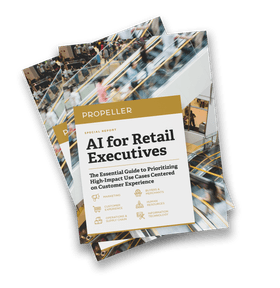Most people’s experiences with AI are still surface-level. They might use a chatbot to answer questions, a tool to write copy, or a virtual assistant that schedules meetings.
But a quiet shift is happening. AI is starting to do more than respond. It’s beginning to take action. Not in a sci-fi, fully autonomous robot sense, but in a practical, here-and-now way that’s already changing how work gets done.
This next evolution is called agentic AI. It’s moving AI from conversation to coordination and from input-output tools to systems that plan, execute, and adapt.
# What Makes AI “Agentic”?
We often think of AI as systems that respond - tools like ChatGPT or customer service chatbots. These are examples of conversational AI, which generate text, speech, or other outputs based on user prompts.
Agentic AI goes a step further. It’s not just about responding; it’s about doing.
- Making decisions autonomously
- Executing multi-step tasks toward a defined goal
- Interacting with its environment (such as apps, systems, or people)
- Adapting its behavior based on feedback or results
This capacity for agency, to act on behalf of a user or system, is what defines agentic AI. It’s the natural evolution of conversational AI tools. By handling routine, goal-driven tasks, these tools will free up people and businesses to focus on higher-value work.
# What Can Agentic AI Do for Business?
Agentic AI unlocks new levels of productivity, especially for tasks that fall between simple, rule-based automation and high-value strategic work. These systems excel in areas where complexity, scale, and coordination are crucial, and where traditional tools often fall short.
With the rise of low-code platforms, system connectors, and orchestration engines, agentic AI is no longer a concept but a practical solution. The use cases are real, especially in operations-heavy teams that rely on multiple tools and workflows.
# Agentic AI Use Cases
Here are a few examples of agentic AI in action:
- Customer Onboarding: An agent reads incoming emails, extracts relevant info, updates your CRM, books intro meetings, and sends follow-ups – all without human intervention.
- Procurement Management: An agent that monitors inventory levels, cross-checks vendor SLAs, triggers Just-In-Time purchase orders, and adapts to supply chain delays in real time.
- Compliance Monitoring: An agent scans internal reports, flags anomalies, and drafts escalation reports, alerting relevant stakeholders while learning from past resolution patterns to continuously improve its performance.
Just a few years ago, concepts like these would have been considered Herculean tasks, requiring highly specialized technical teams and extensive in-house Machine Learning (ML) and Robotic Process Automation (RPA) capabilities. Today, the rise of agentic AI platforms and prebuilt system connectors makes these types of solutions easier than ever to prototype, test, and deploy.
If you're curious which types of use cases are ideal to start with, check out our companion post on prioritizing agentic AI use cases.
Related Content: Don’t Go Full Autonomy (Yet): How to Prioritize Agentic AI Use Cases That Scale
# Agentic AI vs. AI Agents: What’s the Difference?
Due to their nomenclature, it’s easy to confuse AI agents with agentic AI. However, while the two terms are closely related, they’re not interchangeable.
# What is an AI Agent?
An AI agent is a single autonomous unit designed to perform a specific task or set of tasks. For example, an agent might:
- Monitor your email inbox and summarize daily highlights
- Extract structured data from unstructured documents
- Navigate internal systems to pull data for a report
On its own, an AI agent delivers targeted, often impressive functionality. But it remains a building block.
# What is Agentic AI?
Agentic AI, by contrast, refers to a broader system or architecture that coordinates multiple agents, tools, and feedback loops to pursue higher-order goals. It’s about orchestrating these capabilities in a cohesive, intelligent workflow that mirrors how a human might approach a complex task—planning, prioritizing, adapting, and executing over time.
Think of it like a team:
- An AI agent is like a specialist—say, your travel coordinator.
- Agentic AI is like an executive assistant who handles travel, schedules meetings, preps briefing documents, adjusts plans as priorities shift, and collaborates across functions.
This distinction is important for enterprise leaders to grasp. Simply deploying a few smart agents isn’t enough. The real value comes when you design systems that enable agents to work together, share context, and pursue business goals in adaptive, human-like ways.
# Common Misconceptions About Agentic AI
Agentic AI is often misunderstood, especially as tools claim agent-like capabilities. Here are a few of the most common misconceptions we hear:
# 1: It’s just a chatbot with more steps.
Conversational AI (like chatbots or assistants) is designed to respond to input. Agentic AI is designed to pursue outcomes — planning, executing, and adapting across systems.
# 2: It’s basically RPA 2.0.
RPA runs on strict, rule-based logic. Agentic AI incorporates reasoning, handles unstructured data, and adapts to change. It’s not a macro; it’s a collaborator.
Notably, leading RPA vendors such as UIPath and Appian are already evolving their offerings to include agentic AI capabilities, helping provide a ‘best of both worlds’ approach to business automation.
Here’s how agentic AI compares to RPA across some key dimensions:
Technology |
Key Outputs |
Key Limitation |
Robotic Process Automation (RPA) |
Automating repetitive, rules-based tasks across one or more systems |
Rigid – requires highly structured inputs and is ill-suited for adapting to change |
Agentic AI |
Reasons and adapts to context, taking initiative to interact with one or more systems |
Emerging technology – requires careful design, governance/controls, and data readiness |
# 3: It’s too advanced to use today.
Many agentic use cases are already within reach, especially for repetitive, rules-based, or cross-system workflows. The key is knowing where to start.
# 4: It replaces human teams.
Agentic AI doesn’t eliminate jobs — it elevates them. These systems work best when paired with human oversight, judgment, and creativity. The goal isn’t to fully automate roles, but to eliminate repetitive, cross-system friction, allowing teams to focus on higher-value work.
Related Content: Why Treating AI as a Teammate (Not Just Technology) Unlocks Its Full Potential
# 5: It’s only for advanced AI organizations.
You don’t need a dedicated ML team to get started with agentic AI. Many use cases are accessible with existing platforms, low-code tools, and smart orchestration. The key isn’t technical depth, but rather identifying where agents can deliver value safely and sustainably.
# Why It Matters
Agentic AI isn’t just another leap in automation. It’s a shift in how work gets done.
Rather than layering brittle one-off tools across siloed systems, agentic AI enables teams to:
- Automate complex, cross-functional workflows
- Reduce cognitive load on employees
- Expand operational capacity without increasing headcount
Because these systems can reason, adapt, and improve, they enable more than efficiency and unlock a new model of human-machine collaboration.
For organizations under pressure to scale smartly, agentic AI offers a path forward that balances innovation with control and experimentation with structure.
And like any scalable solution, its success depends on thoughtful implementation, including governance structures, change readiness, and data foundations that support responsible deployment.
Related Content: AI Governance: How an AI Council Could Make or Break Your Strategy
# Want to Put Agentic AI to Work?
This post is part of our growing library on building responsible, scalable enterprise AI. To learn where to start, check out our related post on prioritizing agentic AI use cases.
Need help identifying the right opportunities for agentic AI in your business? Let’s talk.

AI for Retail Leaders: Use Case Guide
Learn how leading retailers are using AI to enhance CX, streamline operations, and deliver value.




